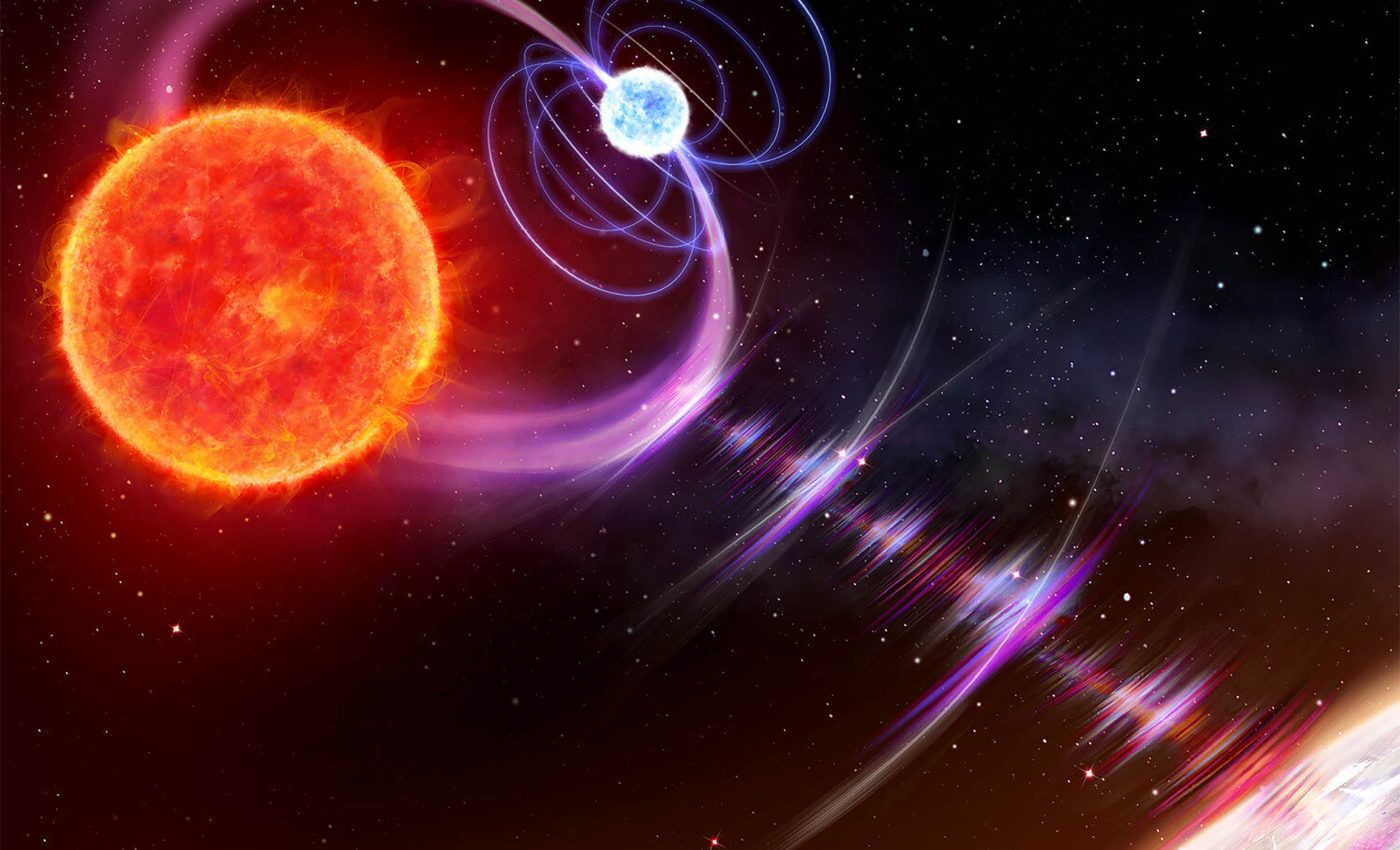
Two tiny stars orbit each other in just 125 minutes and emit unknown radio signals
Scientists recently identified distinct radio signals coming from a pair of stars – a white dwarf and a red dwarf. They orbit each other every 125 minutes, locked in a cosmic dance that has astronomers buzzing.
This challenges earlier assumptions about which stellar objects can generate such bursts of energy. Their discovery is turning heads because it highlights that neutron stars are no longer the only prime suspects for producing unusual radio flashes.
Leading the hunt is Dr. Iris De Ruiter, now at the University of Sydney (Australia), who directed much of the investigation while finalizing doctoral work at the University of Amsterdam.
Strange radio bursts
Astronomers first noticed something peculiar while reviewing data from the LOFAR telescope, which detects low-frequency radio waves.
They found that the two stars occasionally release brief, minute-long bursts that line up with their shared orbit of just over two hours. These bursts stand out as especially strong and highly sporadic.
Additional observations with large U.S. observatories, including the 6.5 meter (21 foot) Multiple Mirror Telescope in Arizona and the Hobby-Eberly Telescope in Texas, backed up the LOFAR findings.
Researchers confirmed that the signals are tied to the stars’ orbital dance, rather than a single rotating body. They now see that the pair’s timing is remarkably precise.
Why dwarf stars matter
The term white dwarf refers to a dense, leftover core of a star that has used up its hydrogen fuel. It often keeps a strong magnetic field, which can generate electric currents if plasma streams from another object.
This system’s red dwarf is a smaller star that may be interacting with the white dwarf’s magnetism in just the right way to spark these radio surges.
Experts note that the signals indicate interactions reminiscent of those seen around highly magnetic neutron.
Yet these observations show that neutron stars do not hold the exclusive right to bright radio pulses.
One research member explained that this find “breaks a sort of monopoly” and hints there may be more of these cosmic double acts waiting to be identified.
Stars sharing gravity
Each blast lines up neatly with the duo’s 125-minute path around their common center of gravity.
The group determined the radio pulses emerge most clearly when the red dwarf lines up behind the white dwarf, as seen from Earth.
This geometry gives scientists a peek at the powerful phenomenon, which likely hinges on intense magnetic connections.
“It was especially cool to add new pieces to the puzzle. We worked with experts from all kinds of astronomical disciplines,” de Ruiter explained.
“With different techniques and observations, we got a little closer to the solution, step by step.” The short, energetic flashes are unlike the usual signals from typical stars.
Dwarf stars and radio signals
Researchers plan to investigate the ultraviolet glow from this system to gauge how hot the white dwarf star truly is.
Such measurements can reveal what processes triggered these extreme bursts and whether more interactions lurk among dim star pairs.
The team also hopes to scour archives of older radio scans for similar signals. This approach might unearth additional pairs that produce intense radio beams.
Some scientists compare these newly discovered signals to “low-speed versions” of pulsars, which are famously fast-spinning neutron stars.
By studying white dwarf binaries in more detail, astronomers might uncover patterns that shed light on magnetic field strengths, mass transfer, and even possible evolutionary paths for double-star systems.
What happens next?
Because these pulses show up at radio wavelengths, there is a chance they might share some elements with other cosmic repeaters, such as those seen in fast radio bursts.
Although most radio bursts of that sort hail from outside our galaxy, exploring how they might arise in local dwarf star pairs is an exciting notion.
This discovery also fuels a hunt for new vantage points. Observatories around the world, and in space, can join forces to capture next-level data from these dwarfs.
By locking in on orbital timing and mapping out the radio brightness, scientists can demystify how stellar magnetism flares to life under these conditions.
Why this discovery is so important
This find challenges long-held assumptions about where intense radio bursts originate. For years, astronomers focused mainly on neutron stars – incredibly dense remnants of supernovae – as the sole engines of such radio activity.
Now, this white dwarf and red dwarf pair shows that more ordinary stellar objects can mimic those extreme behaviors under the right conditions. It also suggests that other low-mass stellar systems may be hiding similar surprises.
If so, the galaxy could be full of hidden binary systems pulsing in ways we’ve only just learned how to detect. Unlocking more of these could reshape how scientists search for exotic signals in the sky.
—–
This global effort also involved the Netherlands Research School for Astronomy, and illustrates the broad reach of modern collaboration.
Image: Artist’s impression of a red dwarf (left) and a white dwarf (center) orbiting each other. This results in radio pulses. Credit: Daniëlle Futselaar/artsource.nl
The study is published in Nature Astronomy.
—–
Like what you read? Subscribe to our newsletter for engaging articles, exclusive content, and the latest updates.
Check us out on EarthSnap, a free app brought to you by Eric Ralls and Earth.com.
—–













